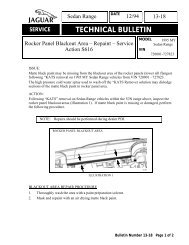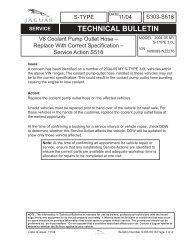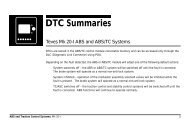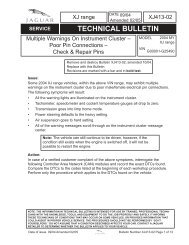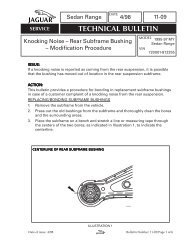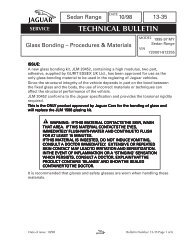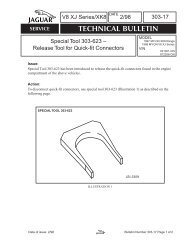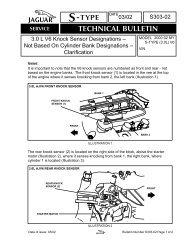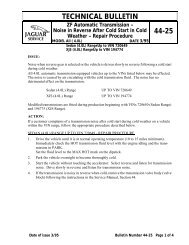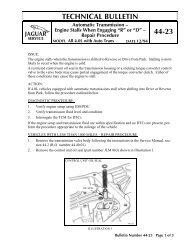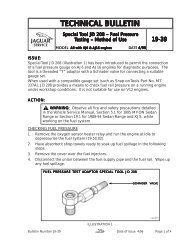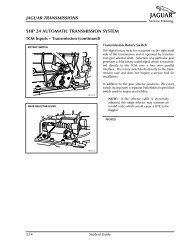Jaguar XJ 1998 - JagRepair.com
Jaguar XJ 1998 - JagRepair.com
Jaguar XJ 1998 - JagRepair.com
Create successful ePaper yourself
Turn your PDF publications into a flip-book with our unique Google optimized e-Paper software.
User Instructions<br />
<strong>XJ</strong> Series <strong>1998</strong><br />
NOTE: In the examples shown on this page, an ‘X’ is used where a number would appear on an actual Figure.<br />
Reference Symbols<br />
Reference symbols are used for three purposes:<br />
• to allow the user to <strong>com</strong>plete the individual system circuit to power supply or ground<br />
• to refer the user to a related circuit<br />
• to identify control module inputs, outputs and signal grounds<br />
X Battery Power Supply<br />
This symbol represents a direct battery power supply and refers the user to Figure 01.1, 01.2 or 01.3.<br />
X X X<br />
I II E Ignition Switched Power Supply<br />
This symbol represents ignition switched power supply and refers the user to Figure 01.1, 01.4 or 01.5.<br />
The suffix I indicates auxiliary power. Power is supplied in ignition switch key positions I (AUXILIARY) and II (IGNITION).<br />
The suffix II indicates ignition power. Power is supplied in ignition switch key positions II (IGNITION) and III (ENGINE CRANK).<br />
The suffix E indicates engine management switched power. Power is supplied in ignition switch key positions II (IGNITION) and III<br />
(ENGINE CRANK) under ECM control.<br />
XX<br />
I<br />
XX<br />
II<br />
X<br />
Ignition Switched Ground<br />
This symbol represents an ignition switched ground and refers the user to Figure 02.1.<br />
This symbol without a suffix indicates CRANK. Ground is <strong>com</strong>pleted in ignition switch key position III (ENGINE CRANK).<br />
The suffix I indicates auxiliary ground. Ground is <strong>com</strong>pleted in ignition switch key positions I (AUXILIARY) and II (IGNITION).<br />
The suffix II indicates ignition ground. Ground is <strong>com</strong>pleted in ignition switch key positions II (IGNITION) and III<br />
(ENGINE CRANK).<br />
XX.X BPM<br />
Figure Number Reference Flag<br />
This symbol refers the reader to a figure number only. It does not refer to a flag with the same number on a different figure.<br />
As used in Figures 01.1 through 02.1, the reference flag refers the user to a continuation of the circuit. In this instance, the<br />
user matches the number to a Power Supply or Ground symbol to trace the circuit.<br />
In most other cases, it is not necessary to refer to another figure for <strong>com</strong>pletion of a circuit, as the reference flags are used<br />
to indicate parallel circuits and circuits that share <strong>com</strong>ponents. Most of the circuits where this situation occurs are overlapped<br />
to avoid the necessity for cross-referencing to another figure. Exceptions to this rule are instances where signals<br />
are transmitted to or received from other system circuits. When circuits are not overlapped, they are noted by (CIRCUIT<br />
CONTINUED).<br />
BPM Because the Body Processor Module appears numerous times, the abbreviation BPM is used in the reference flags<br />
on Figures 01.2 and 02.1 in order to conserve space.<br />
Control Module Input, Output, Data Link, Signal Ground and Network(s)<br />
I O D<br />
C<br />
S<br />
Input Output Serial and Encoded Signal Ground (SG) CAN (Network) SCP Network<br />
Communications<br />
These six symbols are employed to assist the user in visualizing the ‘logic’ of circuits containing control modules. The<br />
symbols identify control module input, output, data link, signal ground and network pins. These symbols are also employed<br />
on the corresponding data page.<br />
14 DATE OF ISSUE: SEPTEMBER 1997





